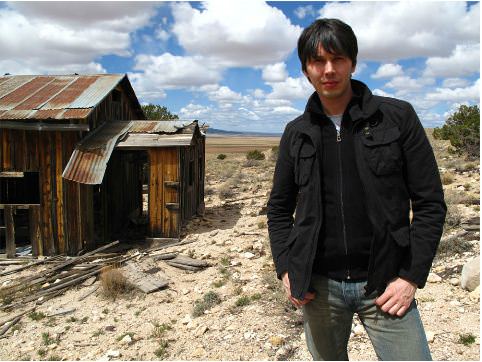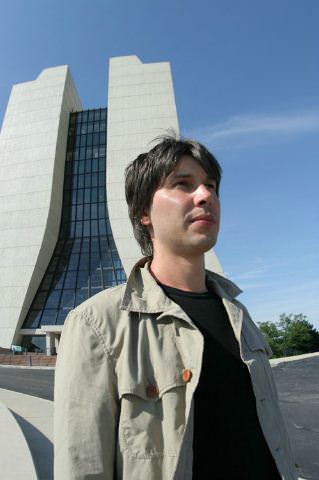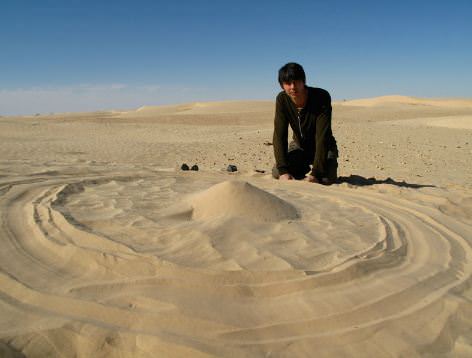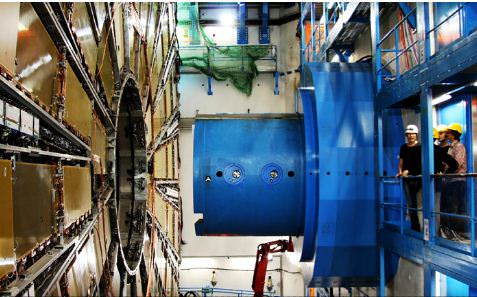[/caption]
At two separate conferences in July, particle physicists announced some provoking news about the Higgs boson, and while the Higgs has not yet been found, physicists are continuing to zero in on the elusive particle. Universe Today had the chance to talk with Professor Brian Cox about these latest findings, and he says that within six to twelve months, physicists should be able to make a definite statement about the existence of the Higgs particle. Cox is the Chair in Particle Physics at the University of Manchester, and works on the ATLAS experiment (A Toroidal LHC ApparatuS) at the Large Hadron Collider at CERN. But he’s also active in the popularization of science, specifically with his new television series and companion book, Wonders of the Universe, a follow up to the 2010 Peabody Award-winning series, Wonders of the Solar System.
Universe Today readers will have a chance to win a copy of the book, so stay tuned for more information on that. But today, enjoy the first of a three-part interview with Cox:
Universe Today: Can you tell us about your work with ATLAS and its potential for finding things like extra dimensions, the unification of forces or dark matter?

Brian Cox: The big question is the origin and mass of the universe. It is very, very important because it is not an end in itself. It is a fundamental part of Quantum Field Theory, which is our theory of three of the four forces of nature. So if you ask the question on the most basic level of how does the universe work, there are only two pillars of our understanding at the moment. There is Einstein’s Theory of General Relatively, which deals with gravity — the weakest force in the Universe that deals with the shape of space and time and all those things. But everything else – electromagnetism, the way the atomic nuclei works, the way molecules work, chemistry, all that – everything else is what’s called a Quantum Field Theory. Embedded in that is called the Standard Model of particle physics. And embedded in that is this mechanism for generating mass, and it’s just so fundamental. It’s not just kind of an interesting add-on, it’s right in the heart of the way the theory works.
So, understanding whether our current picture of the Universe is right — and if there is this thing called the Higgs mechanism or whether there is something else going on — is critical to our progress because it is built into that picture. There are hints in the data recently that maybe that mechanism is right. We have to be careful. It’s not a very scientific thing to say that we have hints. We have these thresholds for scientific discovery, and we have them for a reason, because you get these statistical flukes that appear in the data and when you get more data they go away again.
The statement from CERN now is that if they turn out to be more than just fluctuations, really, within six months we should be able to make some definite statement about the existence of the Higgs particle.
I think it is very important to emphasize that this is not just a lot of particle physicists looking for particles because that’s their job. It is the fundamental part of our understanding of three of the four forces of nature.

UT : So these very interesting results from CERN and the Tevatron at Fermilab giving us hints about the Higgs, could you can talk little bit more about that and your take on the latest findings?
COX: The latest results were published in a set of conferences a few weeks ago and they are just under what is called the Three Sigma level. That is the way of assessing how significant the results are. The thing about all quantum theory and particle physics in general, is it is all statistical. If you do this a thousand times, then three times this should happen, and eight times that should happen. So it’s all statistics. As you know if you toss a coin, it can come up heads ten times, there is a probability for that to happen. It doesn’t mean the coin is weighted or there’s something wrong with it. That’s just how statistics is.
So there are intriguing hints that they have found something interesting. Both experiments at the Large Hadron Collider, the ATLAS and the Compact Muon Solenoid (CMS) recently reported “excess events” where there were more events than would be expected if the Higgs does not exist. It is about the right mass: we think the Higgs particle should be somewhere between about 120 and 150 gigaelectron volts [GeV—a unit of energy that is also a unit of mass, via E = mc2, where the speed of light, c, is set to a value of one] which is the expected mass range of the Higgs. These hints are around 140, so that’s good, it’s where it should be, and it is behaving in the way that it is predicted to by the theory. The theory also predicts how it should decay away, and what the probability should be, so all the data is that this is consistent with the so-called standard model Higgs.
But so far, these events are not consistently significant enough to make the call. It is important that the Tevatron has glimpsed it as well, but that has even a lower significance because that was low energy and not as many collisions there. So you’ve got to be scientific about things. There is a reason we have these barriers. These thresholds are to be cleared to claim discoveries. And we haven’t cleared it yet.
But it is fascinating. It’s the first time one of these rumors have been, you know, not just nonsense. It really is a genuine piece of exciting physics. But you have to be scientific about these things. It’s not that we know it is there and we’re just not going to announce it yet. It’s the statistics aren’t here yet to claim the discovery.

UT : Well, my next question was going to be, what happens next? But maybe you can’t really answer that because all you can do is keep doing the research!
COX: The thing about the Higgs, it is so fundamentally embedded in quantum theory. You’ve got to explore it because it is one thing to see a hint of a new particle, but it’s another thing to understand how that particle behaves. There are lots of different ways the Higgs particles can behave and there are lots of different mechanisms.
There is a very popular theory called supersymmetry which also would explain dark matter, one of the great mysteries in astrophysics. There seems to be a lot of extra stuff in the Universe that is not behaving the way that particles of matter that we know of behave, and with five times more “stuff” as what makes up everything we can see in the Universe. We can’t see dark matter, but we see its gravitational influence. There are theories where we have a very strong candidate for that — a new kind of particle called a supersymmetry particles. There are five Higgs particles in them rather than one. So the next question is, if that is a Higgs-like particle that we’ve discovered, then what is it? How does it behave? How does it talk to the other particles?
And then there are a huge amount of questions. The Higgs theory as it is now doesn’t explain why the particles have the masses they do. It doesn’t explain why the top quark, which is the heaviest of the fundamental particles, is something like 180 times heavier than the proton. It’s a tiny point-like thing with no size but it’s 180 times the mass of a proton! That is heavier than some of the heaviest atomic nuclei!
Why? We don’t know.
I think it is correct to say there is a door that needs to be opened that has been closed in our understanding of the Universe for decades. It is so fundamental that we’ve got to open it before we can start answering these further questions, which are equally intriguing but we need this answered first.
UT: When we do get some of these questions answered, how is that going to change our outlook and the way that we do things, or perhaps the way YOU do things, anyway! Maybe not us regular folks…
COX: Well, I think it will – because this is part of THE fundamental theory of the forces of nature. So quantum theory in the past has given us an understanding, for example, of the way semiconductors work, and it underpins our understanding of modern technology, and the way chemistry works, the way that biological systems work – it’s all there. This is the theory that describes it all. I think having a radical shift and deepening in understanding of the basic laws of nature will change the way that physics proceeds in 21st century, without a doubt. It is that fundamental. So, who knows? At every paradigm shift in science, you never really could predict what it was going to do; but the history of science tells you that it did something quite remarkable.
There is a famous quote by Alexander Fleming, who discovered penicillin, who said that when he woke up on a certain September morning of 1928, he certainly didn’t expect to revolutionize modern medicine by discovering the world’s first antibiotic. He said that in hindsight, but he just discovered some mold, basically, but there it was.
But it was fundamental and that is the thing to emphasize.
Some of our theories, you look at them and wonder how we worked them! The answer is mathematically, the same way that Einstein came up with General Relativity, with mathematical predictions. It is remarkable we’ve been able to predict something so fundamental about the way that empty space behaves. We might turn out to be right.
Tomorrow: Part 2: The space exploration and hopes for the future
Find out more about Brian Cox at his website, Apollo’s Children


Now again rumors are circulating on finding the Higgs Boson, where now the data is near 3-?, which is stronger than ever. At the EPS conference it was seen that both ATLAS and CMS have an excess of events peaking at around 144 GeV. Fermilab had a signal in the same place, recorded by Conway back in 2007, but much weaker. So far the data is from separate detectors, but a statistically appropriate combined plot is supposed to be revealed at the Lepton-Photon conference starting 22nd August. Here the ATLAS and CMS collaborations will unveil their combined plot. The question is, will the combined signal at 144 GeV be enough to announce an observation over 3-? significance?
Some unofficial combinations have been advanced, which have to be taken with a grain of salt, which have a near 3-? confidence. For those not so familiar an n-? result is 1 – e^{-2n} statistical confidence, so 3-? is 1 – e^{-6 } = .99752. This is pretty good, and 3-? is the bottom limit.
LC
If Higgs particle is confirmed then its good, but if not then not only Standard Model will suffer, also the inflationary theory would have to look to “brane inflation” rather then higgs field….
Am I right?
I entertained an idea a bit like this some years ago. I abandoned it. Unless somebody can work up something different from what exists I would hesitate to sign on to this. The eternal inflation model involves a quartic type of potential, which is “Higgs-like,” but for various reasons it does not work. The main problem is it puts the Higgs field up to near the string scale and the vacuum is not stable.
LC
And as we all know nature abhors an unstable vacuum!
I envy you and some of the other commentators who appear to get the math for these sorts of phenomena. Working with concepts leaves one constantly refining analogies rather than dealing with the more exact and subtle language of mathematical models.
Dogs and cats abhor the vacuum!
My wife rather likes Brian, I never thought she’d fall for a scientist!
I rather like Brian as well; or more specifically, his series “Wonders of the Universe”.